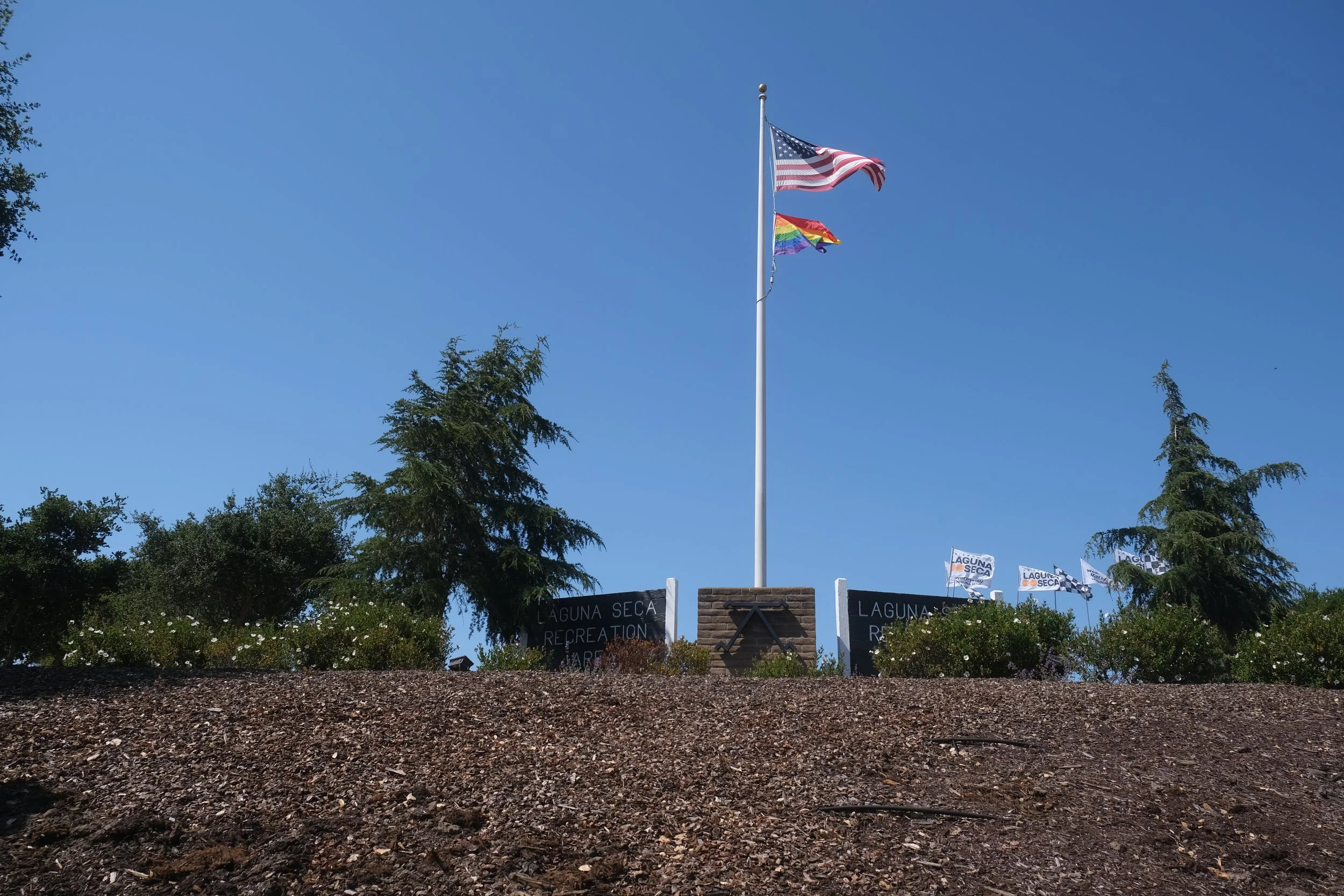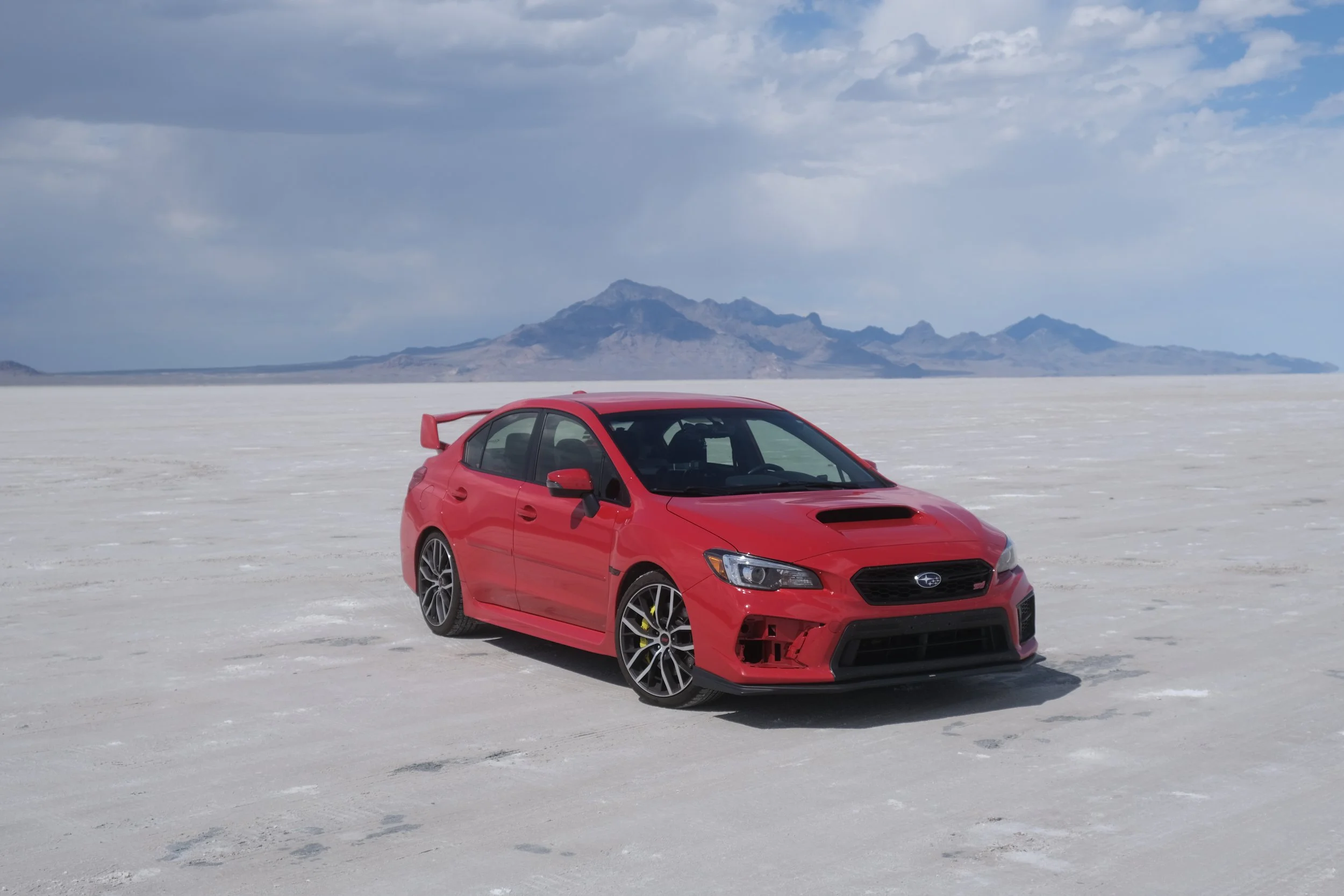Our 8,200-Mile Trip, Part 2: PCH, Redwoods, and an F1
There’s a special kind of exhaustion that comes from leaving Las Vegas. It’s not just a lack of sleep or a questionable buffet; it’s a deep, soul-level fatigue from existing for even less than 24 hours in a city that’s actively trying to trick all five of your senses at once. Leaving the air-conditioned tomb of the MGM Grand and getting back into the STi felt like surfacing for air. We were officially done with the desert. It was time to find the ocean.
The San Diego Zoo sign
The drive from Vegas to San Diego is a journey back to reality. The Mojave Desert slowly gives way to rolling hills, and the temperature on the dash begins to drop from "Oh God" to "Oh, this is nice." Pulling into San Diego was a relief. The air was cool, the sun was pleasant, and for the first time in what felt like weeks, we weren't actively being cooked alive.
After finding a hotel with a parking garage that didn't look like it specialized in stolen catalytic converters (a constant, low-grade anxiety when you’re driving your own car), and after we did a very CA thing by introducing Ryan to In-N-Out (which he LOVED BTW! Well, he loved the burgers, he did not love the fries which I think is a pretty common reaction) we decided to do the most normal, non-car-guy thing imaginable: go to the zoo.
The San Diego Zoo is famous for a reason. It’s huge, it’s beautiful, and it was a perfect chance to stretch our legs and remember what it felt like to not be vibrating at 3,000 RPM. We saw the pandas, the polar bears, the whole nine yards. And then, standing near the cassowary enclosure, the trip’s next bizarre moment found us.
That Time We Met Jason Segel
〰️
That Time We Met Jason Segel 〰️
You know that moment when you see a famous person in real life? Your brain does a quick reboot. "That person looks exactly like Jason Segel. Wait. That's because it IS Jason Segel."
He was there with someone, just trying to have a normal day. And there we were, two road-tripping idiots, trying to do the same. We were staring at a cassowary—which, if you don’t know, is basically a modern-day velociraptor that will absolutely ruin your day if you get too close. Trying to be funny, I turned to Ryan and said, a little too loudly, “That’s not a bird, that’s a straight-up dinosaur.”
From about ten feet away, Jason Segel chuckled. It wasn't an over-the-top reaction, but a clear, amused chuckle. He glanced over, a smile flickered across his face, and he gave a subtle nod, as if acknowledging the absurdity.
And that was it. We didn’t bother him for a picture. The man was with someone and clearly enjoying a bit of privacy. Besides, we had learned our lesson about awkward fan encounters in Albuquerque. But we made eye contact and he laughed at my joke, so I think it's safe to say we're best friends now. I'm expecting his call to co-star in his next movie any day now. While I wait, you can check out all the photos we took of the actual animals in the gallery at the end of this post.
It was official. Even when we tried to take a day off from the road trip, the road trip wasn't done with us. Next stop: the legendary traffic and car culture of Los Angeles.


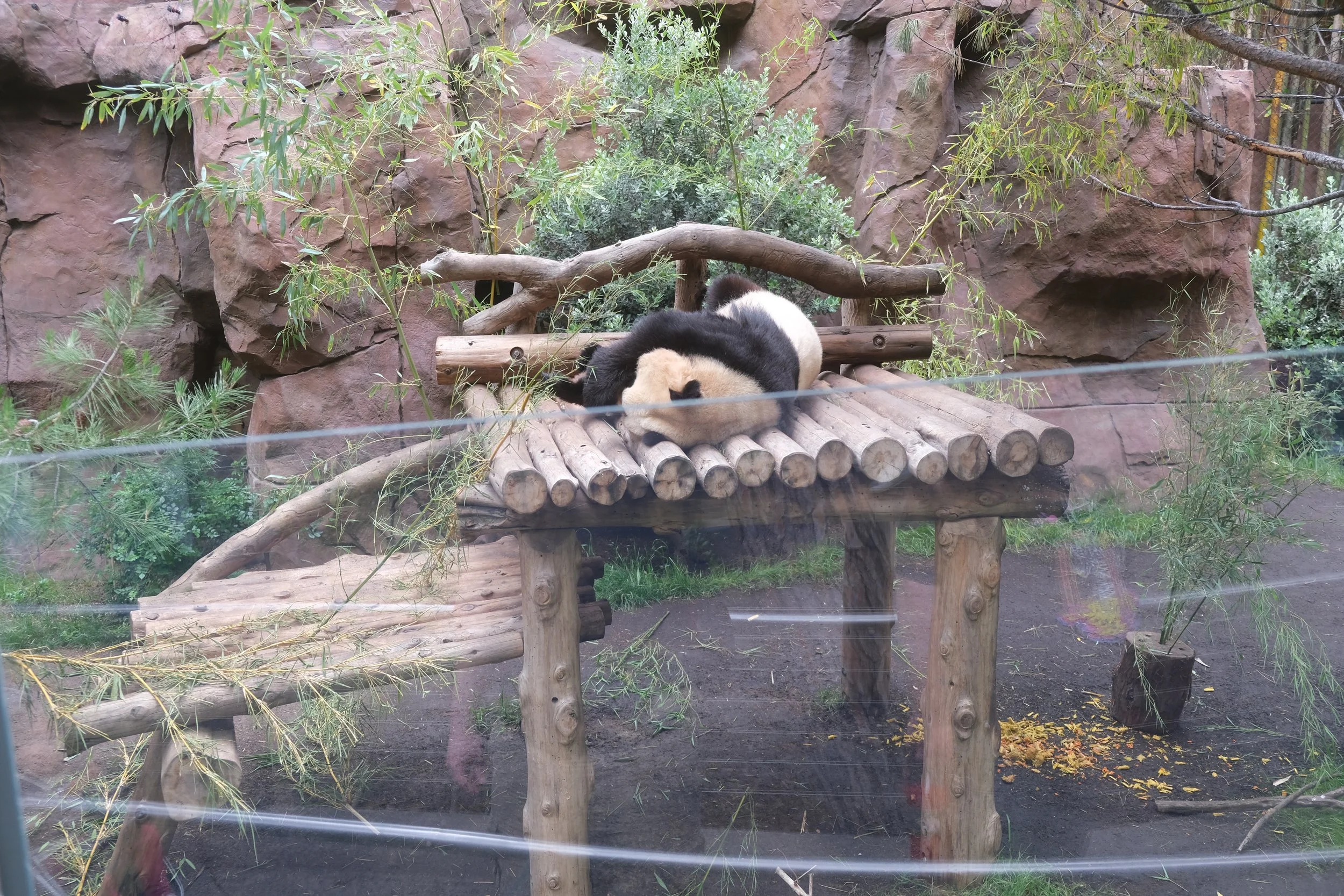













From Freeway Hell to Canyon Heaven
〰️
From Freeway Hell to Canyon Heaven 〰️
Our plan in Los Angeles was to spend about a week, using it as a home base. Leaving the relaxed vibe of San Diego for LA is like going from a pleasant conversation to a shouting match. The moment you hit the LA county line, the freeways expand to a dozen lanes across, yet somehow, none of them are moving.
LA traffic is a spectacle. For a car person, it's both a museum and a prison. In the span of fifteen minutes, you’ll see a brand-new McLaren weaving through traffic like it's a video game, a '64 Impala on hydraulics in the next lane, a fleet of identical Teslas, and a clapped-out '90s Civic with a giant wing. It’s the most diverse and chaotic car show on earth, and you’re forced to enjoy it at a brisk 4 miles per hour.
Driving the STi here was, once again, the insane choice. The stiff clutch pedal becomes your worst enemy in stop-and-go traffic on the 405. The firm suspension translates every one of LA’s legendary potholes directly into your fillings. For the better part of a week, any trip across town was a miserable, grinding affair.
But we weren't there for the freeways. We were there for the canyons.
After escaping the urban sprawl, we headed for the hills of Malibu. And this is where the STi, a car that makes no sense in the city, suddenly became the only car in the world we wanted to be driving. The tight, technical, winding roads that snake through the canyons are what this car was built for. All the things that made it a pain in traffic—the stiff ride, the turbo lag, the heavy clutch—were forgotten.
Here, the firm suspension kept the car impossibly flat through switchbacks. The turbo spooled up on the short straights, and the all-wheel-drive system clawed for grip out of tight hairpins. For days, we explored those legendary roads, carving up and down the mountainsides with the Pacific Ocean as a backdrop. This was the payoff. Every moment of frustration on the 405 was the price of admission for this perfect driving experience.
After a week of intense driving and city chaos, we needed a place to decompress. We pointed the car north to our next stop: Santa Barbara. The drive itself is beautiful, a more relaxed version of the coast. Santa Barbara felt like a different world—calm, beautiful, and a welcome respite. It was the perfect place to recharge before tackling the next leg of the journey.
Next stop, the city of fog and hills: San Francisco.
Monterey: A Pilgrimage to Car Heaven
〰️
Monterey: A Pilgrimage to Car Heaven 〰️
Leaving the calm of Santa Barbara, we pointed the STi north with a legendary destination in our sights: Monterey. For car enthusiasts, Monterey isn't just a city; it's a pilgrimage. It's home to Pebble Beach, historic racing, and, most importantly for us, a world-famous ribbon of asphalt called WeatherTech Raceway Laguna Seca.
Pulling up to the gate of a track you’ve spent hundreds of hours driving in video games is a surreal experience. We didn't have a track day booked; we were just hoping to get a glimpse. In a moment of pure luck, the security guard was incredibly cool and waved us through, letting us drive up to the fence for photos. We parked the STi and soaked it all in. Getting those shots of our own car at a place this iconic was a definite trip highlight.
As we were floating on cloud nine, leaving the track and heading back to the main road, the universe decided to one-up itself. A flash of red went by in the other direction. It was low, wide, and had a shape that was instantly, shockingly familiar.
"Is that...?" "No, it can't be." "Dude. I think that was a McLaren F1."
A frantic GoPro check confirmed it. We had just crossed paths with a literal unicorn. For those who don't know, the F1 isn't just a supercar; it's arguably the supercar, a holy grail of '90s engineering with a center-seat driving position and a price tag that numbers in the tens of millions. After a bit of nerdy internet sleuthing later, we're pretty sure it was chassis #042. It’s one of the rarest and most valuable cars on the planet, just out for a casual drive. It was an insane, once-in-a-lifetime moment that lasted about three seconds.
Its a legit unicorn. An F1 .. just out driving. That’s a rental spec Corolla behind it! Wild.
Still buzzing from our encounters with automotive royalty, we drove into Monterey itself and made the obligatory stop at Cannery Row. It’s touristy, sure, but you have to see the historic buildings and take in the scene that Steinbeck made famous.
From there, we hit the Pacific Coast Highway for the final leg to San Francisco. We treated SF as a "greatest hits" tour—we didn't stay long, but we had to do the classics. We pointed the STi down the ridiculously twisty Lombard Street, crossed the majestic Golden Gate Bridge, and yes, experienced the gut-wrenching hill starts firsthand. It's a beautiful city, but our minds were still back on that flash of red outside Laguna Seca.
It was time to leave the coast behind and head for a completely different kind of giant: the Redwoods.
Redwoods
〰️
Redwoods 〰️
The STi looking smol
After the human-scale world of cities, cars, and racetracks, the drive north into the Redwood forests felt like entering another dimension. We took the scenic route, the Avenue of the Giants, which winds directly through the heart of these ancient behemoths. The drive itself is breathtaking, so we mounted a 360 camera to capture the feeling of piloting a car through this forest of giants. You can experience the entire drive for yourself in the interactive video embedded below!
Even with the video, we ran into a problem with still photos. You see a tree that looks more like a skyscraper, so you pull over. You point your phone, you point the fancy camera, and the photo that comes out is… fine. It’s a picture of a big tree. What it completely fails to capture is the soul-crushing, mind-bending scale of the place. You've probably felt this before, maybe at the Grand Canyon or looking at a massive skyscraper. Your brain understands the scale, but the photo just looks flat.
You try to use your car for perspective. But the STi, a normal-sized car, just looks like a toy parked at the base of something that doesn't seem real. In person, you are craning your neck, physically unable to see the top. The tree isn’t just tall; its presence feels ancient and overwhelming. But in the picture? It’s just a Tuesday. It’s a frustrating and humbling lesson in the limits of photography.
So we put the cameras down for a bit and just soaked it in. We stood at the base of these giants, feeling the quiet and the history in the air. It’s a different kind of awe than seeing a rare car. It’s a primal, enduring beauty that makes you feel temporary in the best way possible.
Of course, we couldn't be reverent for the entire time. We still had a tree to drive through. A short detour brought us to the legendary Chandelier Tree. This privately-owned Redwood has a large hole carved through its base, allowing cars to actually drive through it. It's the kind of slightly ridiculous, completely unforgettable roadside attraction that feels like peak Americana. Carefully maneuvering the STi through the opening, with what felt like inches to spare on either side, was surreal. It’s absurd, it’s touristy, but it’s also undeniably cool to say you’ve driven your car through a living tree. We got the obligatory photos of the STi emerging triumphantly from the other side.
Leaving the hushed grandeur and drive-thru oddities of the Redwoods, we finally started our turn east. The Pacific Coast dream was fading in the rearview mirror, replaced by the promise of mountain air and a legendary alpine lake. Next stop: Lake Tahoe.
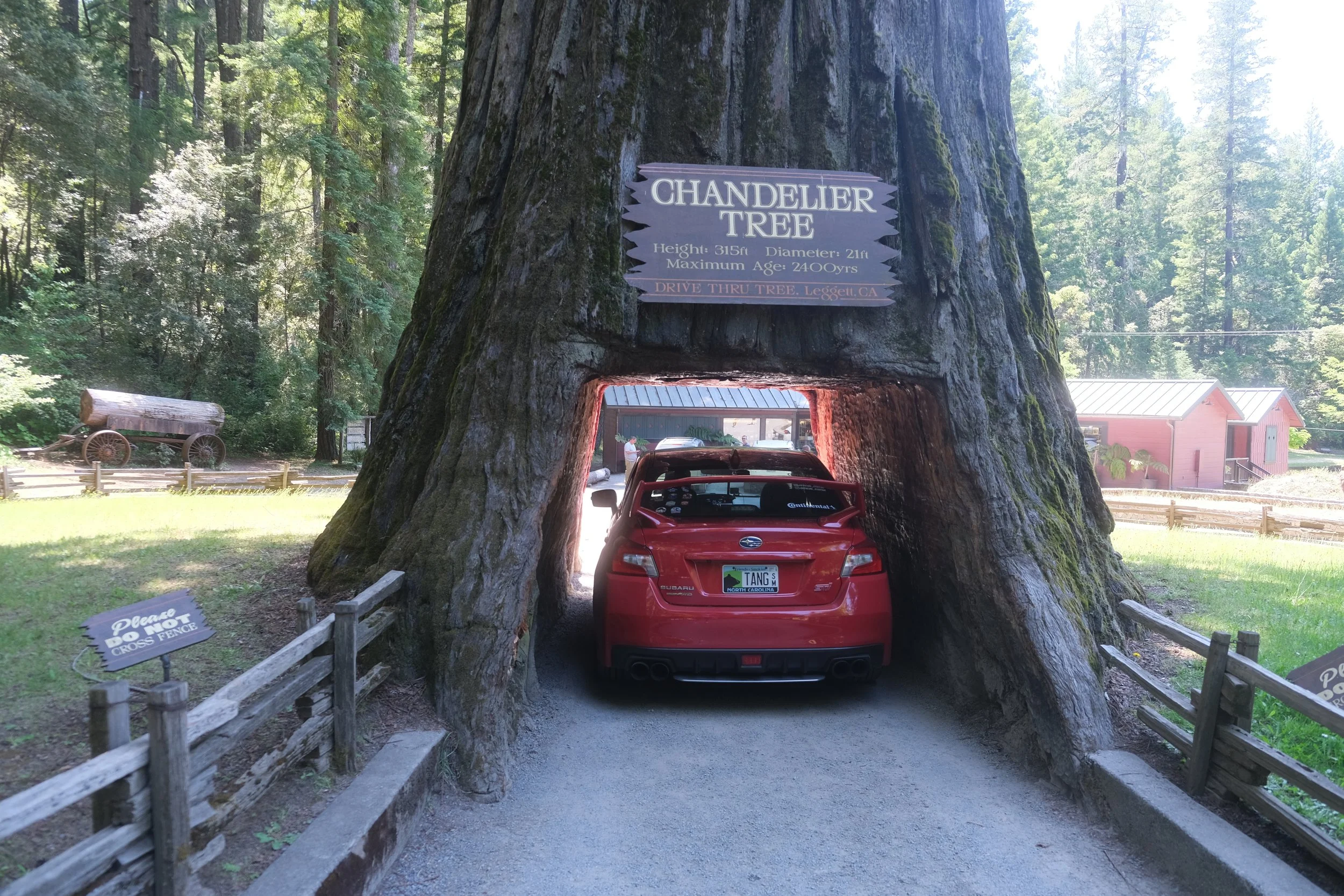








Tahoe
〰️
Tahoe 〰️
Leaving the Redwoods, we pointed the STi east and began the long climb into the Sierra Nevada. You can feel the change in the air—it gets thinner, crisper. The car feels it, too; a turbocharged engine has to work a little differently at 7,000 feet. Then you come over a crest and see it. The photos don't lie; Lake Tahoe is a stunning, almost impossibly blue body of water.
But here’s the thing they don’t always tell you: for a place so defined by its water, it’s surprisingly hard to actually get to it. We found ourselves driving along these incredible shores, looking at that crystal-clear water, but were constantly met with private property and a frustrating lack of public access points. We just wanted to find a spot to pull over and dip our hands in, but it felt like the whole lake was behind a velvet rope.
When we did find the scenic pull-offs, like the one overlooking Emerald Bay, the views were undeniably awesome. The waterfall there is epic and tumbles down the rock face exactly like you’d hope. The scale and beauty are legit.
To get the full "Tahoe experience," we stopped at a local burger joint. The burgers were… fine. They were perfectly adequate burgers. But the experience felt like the most Tahoe thing imaginable. Sitting there, eating our okay-but-overpriced burgers, we noticed we were in an absolute Subaru stronghold. It seemed like every other car was a Subaru, confirming our STi was, at least thematically, in the right place.
In short, Lake Tahoe is every bit as gorgeous as people say. The views are world-class. But I’m not sure it was the draw for us that it seems to be for others. It felt more like a place to look at from a distance than a place to truly experience.









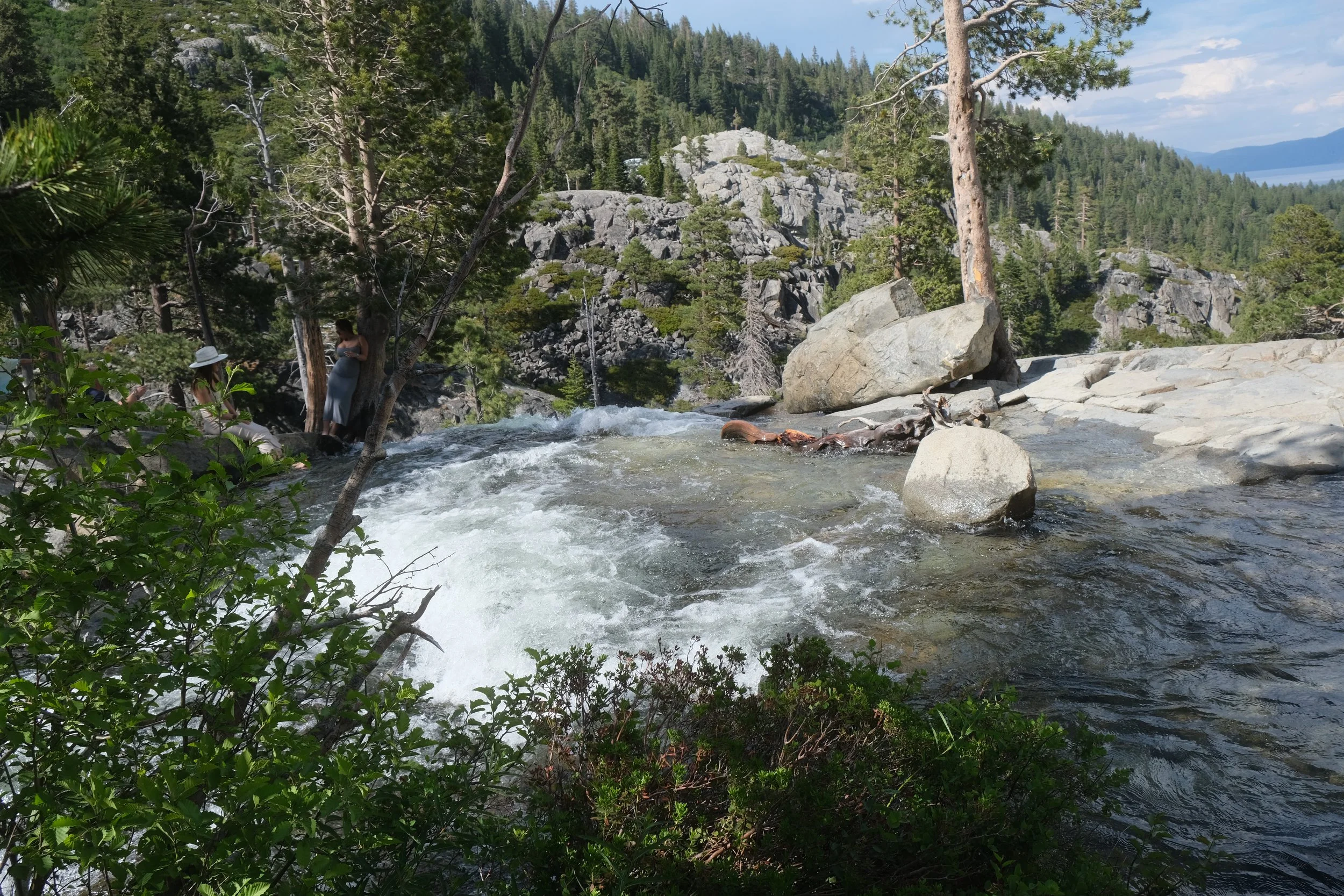


With our burgers finished and our Subaru-spotting quota met, it was time to make the final descent of our West Coast tour. Next stop, we drop down into "The Biggest Little City in the World": Reno.
The Road to Zion
〰️
The Road to Zion 〰️
The STi against the stark backdrop of the hallowed grounds of the Salt Flats
Dropping down from the high altitude of Lake Tahoe into Reno felt like re-entering the real world. Reno marked the official end of our Pacific Coast dream. From here on out, the compass was pointed east. The goal was St. George, Utah—the gateway to Zion National Park. The reality was a lot of miles to cover to get there.
The drive across Nevada is an exercise in endurance. It's the part of a road trip that doesn't make the highlight reel: vast, empty stretches of the Great Basin desert, ruler-straight roads that stretch to a shimmering horizon, and a feeling of being truly in the middle of nowhere. It's a time for podcasts, questionable gas station coffee, and just letting the miles tick by.
But in the middle of this long, flat expanse lies a place of pilgrimage for any car person: the Bonneville Salt Flats.
For a car guy, this is hallowed ground. This isn't just a cool landscape; it's a cathedral of speed where legends were born and the absolute limits of physics have been tested for over a century. You see it from miles away, a brilliant, blinding white patch on the earth that doesn't look real. Stepping out of the car, the heat is intense, the air is bone dry, and the sheer vastness makes you understand how someone could get lost out here.
The scene was a perfect slice of car culture. We saw people camping right on the salt, others like us just taking photos, and, hilariously, a Kia Soul absolutely ripping high-speed runs across the flats. But when we went to line up the STi for our own "hero run," we discovered a truth the pictures don't tell you: the salt, while flat overall, isn't smooth. It's a bumpy, jarring surface.
The temptation to put the hammer down was immense. But then reality set in. Our STi was loaded down with us, multiple week's worth of luggage, and all our camera gear. We still had thousands of miles to go to get home, and this was our only ride. As much as the fantasy of a high-speed pass danced in our heads, the responsible, sane part of our brains took over. We took our photos, soaked in the history, and made our peace with it. We'll leave pushing the limits of human engineering to those crazy enough to try and break records.
Leaving the salt flats behind, we crossed into Utah and pointed the car south. The landscape began to change again, the desert scrub slowly giving way to the iconic red rock formations that signal your approach to Utah's national parks. We rolled into St. George exhausted but full of anticipation. We had made it. We were on the road to Zion.






























